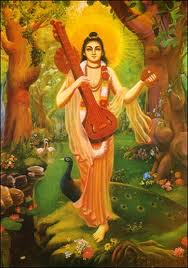NARADA PURANA |
|
 |
'Shraddha-Bhakti', the corner stones of Supreme Realization Maharshi Sanaka assured Devarshi Narada that ‘Shraddha’(Faith) and ‘Bhakti’(Devotion) were the corner-stones of realizing Narayana; Shraddha purvah Sarva Dharmaa Manoratha phala pradaah, Shraddhayaa Saadhyatey Sarvam Shraddhaya tushyatey Hari/ (Any Dharmik task performed with faith would yield fruits; Bhagavan Srihari is satisfied only with Shraddha alone). Any amount of ‘Daan’(charity), ‘Tapasya’ (Meditation), Yagnas along with Dakshinas would be rendered waste without Shraddha-Bhakti ; daan of as much of gold as Meru Mountain or Tapasya drying of one’s own body, or executing ‘Vedokta Ashwamedha Yagnas’ would never attract Bhagavan’s attention without faith and devotion. |
Sanaka Maha Muni underlined three major facets viz. ‘Satsang’ or Company of Bhagavat Bhaktas, Vishnu Bhakti and a strong feeling of equanimity while experiencing joy or sorrow. Given these basic strengths, observation of the Purusharthas of Dharma-Artha-Kama-Moksha within the precincts ‘Varnashrama’ regulations constitute the firm steps to Realization of the Supreme.When asked about the features of a ‘Model Bhakta’, Maharshi Sanaka cited the great example of Markandeya to Narada Maha Muni who had such unfailing faith and devotion to Bhagavan Narayana. In the days of yore, Maharshi Bhrigu’ son Mrikunda did very rigorous ‘Tapasya’, as Lord Indra was apprehensive and approached Narayana that Mrikandu’s Tapasya might not pose threat to his own Chair at Swarga. Bhagavan assured Indra that Mrikunda’s meditation was certainly not for the Swarga throne; he gave his Appearance before Mrikunda and asked him to ask for a favour. The Sage said that indeed Vishnu’s ‘Sakshaatkar’ (Direct Appearance) was paramount by itself; yet since Bhagavan offered to bless the Sage, he would secure a glorious son with high accomplishments and long life. Thereafter the Sage was married and got a son called Marakandeya who was brought up in a typical Vedic kind after reaching his fifth year’s ‘Upanayana’/ ‘Gayatri Upadesha’ (Instruction of Gayatri Mantra), the Sage taught the boy to practice Brahmacharya, reverence to the Elders and the Learned, Tapasya, Yagna, Adhyayana or constant reading and absorption of knowledge and supreme Vishnu Bhajana-Dhyana-Puja. Bhagavan Vishnu blessed Markandeya to script ‘Purana Samhita’; he further blessed Markandeya to become ‘Chiranjeevi’; One thousand Chatur Yugas make one day to Brahma and the latter’s life span is one hundred years of day/night, which is one day of Vishnu. Markandeya survived the ‘Ati Maha Pralaya’ with Vishnu’s ‘Mahima’ and when extolled Vishnu in his ‘Yoga Nidra’, the latter blessed Markandeya to witness such ‘Srishti’ once afresh! Bhagavan Vishnu himself described the characteristics of a Model Bhagavat Bhakta to Markandeya: Such a person wishes the happiness of all Beings and complains against none; has no envy but controls one’s mind and body; has no desire and anxiety; does not hurt any body through mind, conversation and action; has no desire to possess nor a habit to take; has spontaneity in hearing, learning and absorbing anything related to ‘leelas’ or miracles of Bhagavan or of Bhaktas who demonstrate their marvels due to their Powers obtained by the grace of Bhagavan; strongly believes and serves one’s mother as Ganga and father as Bhagavan Vishvanath; fully involves in ‘Puja’ by himself or assists in performing the worship, or even witnesses or at least approves of a Puja actively; distances from those who ridicule those performing Vratas, service to ‘Yatis’ (God men or women) and tasks related to devotion and duty; considers the advice of others for one’s own good and act with discretion by absorbing what is approved of one’s conscience; treats everybody alike without prejudice or ego; is an active protagonist of the virtues of Dharma Shastras and truthfulness; publicises Puranas and their contents; serves cows and Brahmanas and encourages promotion of their causes; undertakes and organizes ‘TirthaYatras’; is genuinely happy at the progress of other’s activities and supports them; involves in the tasks of construction of public gardens, temples, water bodies, wells, resting places of tourists without expecting returns; immerses in ‘Hari nama smarana’ by way of Bhajans, Stutis, group activities of religious nature and plays active role in such movements; has immense interest in Tulasi-related tasks like worship, wearing on person and enjoying the fragrance; observes ‘Varnashrama dharma’; performs ‘Atithi Seva’ or service to Guests; engrosses in taking the name of Shiva, wears ‘Rudraksha malas’ and ‘Vibhuti’(ash) all over the body; observes Vishnu and Shiva with equal devotion and conviction that both are one and the same; observes daily Agnihotra Homa and recites Ashtakshari or Panchakshari Japa always viz. Om Namo Narayanaya or Om Namah Shivaya; and performs whatever ‘danaas’ (charities) are possible without publicity or for name, especially ‘Anna daana’, Jala daana, Go daana, Vastu daana, Kanya daana, etc. Basically, a Bhakta ought to control ‘Panchendriyas’ (the Eyes, Ears, Nose, Tongue and Skin) as also ‘Karmendriyas’(Pada, Hasta, Vacha, Paya and Upastha or feet, hands, speech, excretion and genitals) and most importantly the ‘manas’ or the mind. In brief he should observe the maxim of ‘do good and be good’ and that is a Bhakti all about! Lord Vishnu assured Markandeya that practice of Dharma on the above lines would further his life till the next ‘Maha Pralaya’ leading to ‘Parama Moksha’. |
|
| Narada Purana Home | Next: Sacred Ganga from VishnuÆs feet to Earth by BhagirathaÆs tenacity |
Back to the News Page